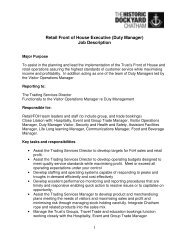sporting - Leisure Opportunities
sporting - Leisure Opportunities
sporting - Leisure Opportunities
Create successful ePaper yourself
Turn your PDF publications into a flip-book with our unique Google optimized e-Paper software.
HEALTH & FITNESS<br />
The growth of the low cost gym<br />
sector is giving the health and fitness<br />
market a boost, finds Sheffield Hallam<br />
University's <strong>Leisure</strong> Forecast report.<br />
Themis Kokolakakis explains the findings<br />
LOW COST<br />
FITNESS<br />
A<br />
supply-induced expansion<br />
is the basis for a<br />
significant improvement<br />
in the fortunes of health<br />
and fitness operators<br />
despite the uncertain economic environment<br />
in the UK and Europe.<br />
In 2012, the health and fi tness market<br />
is expected to reach £2,265m<br />
(US$3,596m, E2,707m) in value, representing<br />
an increase of 2 per cent in<br />
real terms. This is mainly measured<br />
by the number of members or participants.<br />
During the period 2011 to<br />
2015, the market, despite its maturity,<br />
is expected to grow by almost 12<br />
per cent in real terms.<br />
MEMBERSHIP EXPANSION<br />
In terms of membership, the market<br />
is dominated by David Lloyd (450,000<br />
members), Virgin Active and Fitness<br />
First. However, it is still open to acquisitions<br />
and consolidation – especially<br />
amid the current economic climate.<br />
The economic decline, primarily in<br />
Europe and secondarily in the UK, has<br />
had a triple effect on the economics of<br />
health and fitness operators.<br />
Firstly, low-cost operators have had<br />
an ideal opportunity for expansion;<br />
secondly, the big chains, with plans to<br />
expand abroad, have had to reconsider<br />
the risk against the expected benefi t;<br />
and thirdly, the UK market, despite its<br />
<strong>Leisure</strong> Forecasts predicts that the<br />
health and fitness market will grow by<br />
12 per cent between 2011 and 2015<br />
maturity, has presented an opportunity<br />
for expansion by US chains.<br />
LOW-COST BOOST<br />
The sector pushing forward most<br />
aggressively is the low-cost 24-hour<br />
opening gym. Examples include The<br />
Gym Group and Pure Gym – low-cost<br />
operators which offer the use of facilities<br />
without a monthly contract and are<br />
open 24 hours a day.<br />
Last year Pure Gym raised funds<br />
(£10m, US$16m, E11.7m) to enable<br />
it to expand across the UK. It plans to<br />
open 20 new locations by the end of<br />
2012, taking its portfolio to 45 clubs,<br />
while The Gym Group, with 20 clubs, is<br />
also fully funded to open 20 new sites<br />
a year for the next four years.<br />
Budget gyms are faster and cheaper<br />
to build, which is the main reason for<br />
the interest shown by US chains. Plus,<br />
only three per cent of existing health<br />
clubs are in the low-cost category, so<br />
the potential is immense, not only<br />
for taking market share, but also for<br />
attracting new participants in the market.<br />
Indeed the initial reports are very<br />
encouraging in this regard.<br />
Another signifi cant development<br />
was the opening of the fi rst easy-<br />
Gym clubs in Slough and Wood Green<br />
last year. The easyGym company<br />
has a policy of offering pay-as-you-go<br />
monthly fees without requiring a longterm<br />
contract. Its business plan is to<br />
open 10 clubs per year, although rollout<br />
activity seems to have slowed.<br />
66 Read <strong>Leisure</strong> Management online leisuremanagement.co.uk/digital ISSUE 2 2012 © cybertrek 2012
















